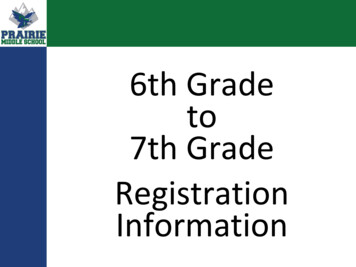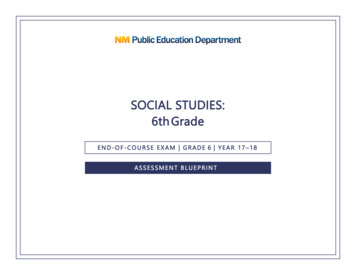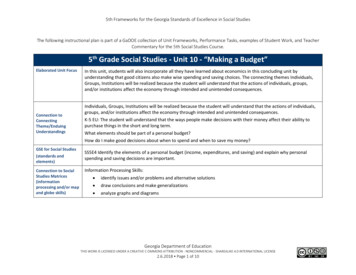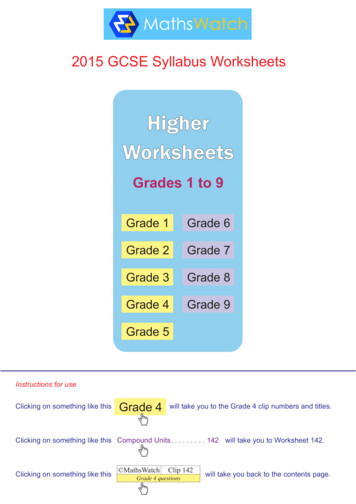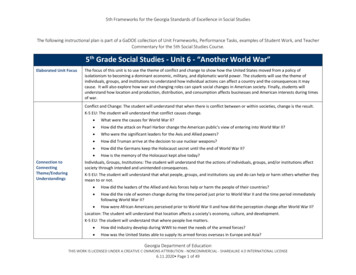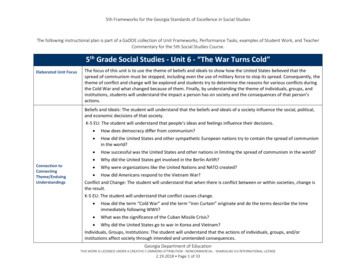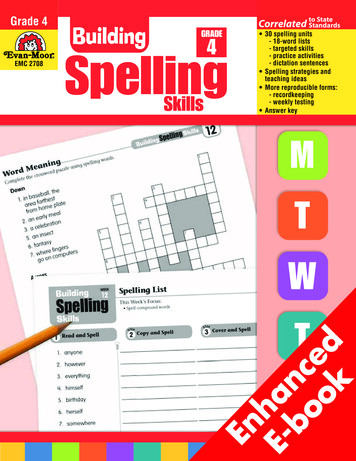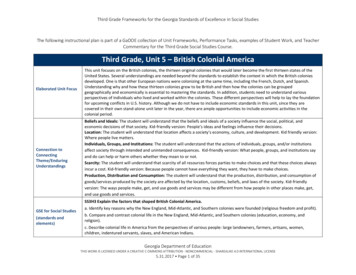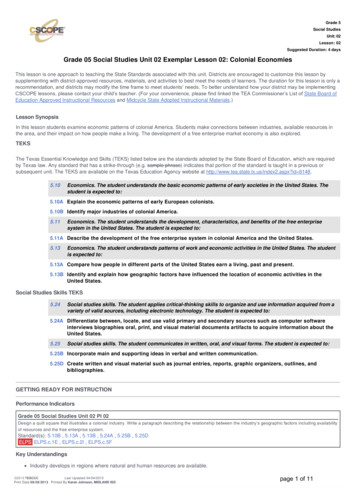
Transcription
Grade 5Social StudiesUnit: 02Lesson: 02Suggested Duration: 4 daysGrade 05 Social Studies Unit 02 Exemplar Lesson 02: Colonial EconomiesThis lesson is one approach to teaching the State Standards associated with this unit. Districts are encouraged to customize this lesson bysupplementing with district-approved resources, materials, and activities to best meet the needs of learners. The duration for this lesson is only arecommendation, and districts may modify the time frame to meet students’ needs. To better understand how your district may be implementingCSCOPE lessons, please contact your child’s teacher. (For your convenience, please find linked the TEA Commissioner’s List of State Board ofEducation Approved Instructional Resources and Midcycle State Adopted Instructional Materials.)Lesson SynopsisIn this lesson students examine economic patterns of colonial America. Students make connections between industries, available resources inthe area, and their impact on how people make a living. The development of a free enterprise market economy is also explored.TEKSThe Texas Essential Knowledge and Skills (TEKS) listed below are the standards adopted by the State Board of Education, which are requiredby Texas law. Any standard that has a strike-through (e.g. sample phrase) indicates that portion of the standard is taught in a previous orsubsequent unit. The TEKS are available on the Texas Education Agency website at http://www.tea.state.tx.us/index2.aspx?id 6148.5.10Economics. The student understands the basic economic patterns of early societies in the United States. Thestudent is expected to:5.10A Explain the economic patterns of early European colonists.5.10B Identify major industries of colonial America.5.11Economics. The student understands the development, characteristics, and benefits of the free enterprisesystem in the United States. The student is expected to:5.11A Describe the development of the free enterprise system in colonial America and the United States.5.13Economics. The student understands patterns of work and economic activities in the United States. The studentis expected to:5.13A Compare how people in different parts of the United States earn a living, past and present.5.13B Identify and explain how geographic factors have influenced the location of economic activities in theUnited States.Social Studies Skills TEKS5.24Social studies skills. The student applies critical-thinking skills to organize and use information acquired from avariety of valid sources, including electronic technology. The student is expected to:5.24A Differentiate between, locate, and use valid primary and secondary sources such as computer softwareinterviews biographies oral, print, and visual material documents artifacts to acquire information about theUnited States.5.25Social studies skills. The student communicates in written, oral, and visual forms. The student is expected to:5.25B Incorporate main and supporting ideas in verbal and written communication.5.25D Create written and visual material such as journal entries, reports, graphic organizers, outlines, andbibliographies.GETTING READY FOR INSTRUCTIONPerformance IndicatorsGrade 05 Social Studies Unit 02 PI 02Design a quilt square that illustrates a colonial industry. Write a paragraph describing the relationship between the industry’s geographic factors including availabilityof resources and the free enterprise system.Standard(s): 5.10B , 5.13A , 5.13B , 5.24A , 5.25B , 5.25DELPS ELPS.c.1E , ELPS.c.2I , ELPS.c.5FKey UnderstandingsIndustry develops in regions where natural and human resources are available.Last Updated 04/04/2013Print Date 08/28/2013 Printed By Karen Johnson, MIDLAND ISDpage 1 of 11
Grade 5Social StudiesUnit: 02Lesson: 02Suggested Duration: 4 days—Why do industries develop in areas that have natural and human resources?——What happens when the resources change?How did the free enterprise system develop in colonial America?Vocabulary of Instructionindustryeconomicseconomic patterngeographic factorsresourcesfree enterpriseMaterialsDrawing paperGlue sticksInformation on industries of colonial AmericaMap, regions of the 13 colonies – New England Middle, Southern (1 per student)Markers or colored pencilsPaper, Colored or white paper (1 per student)Scissors (1 per student)AttachmentsAll attachments associated with this lesson are referenced in the body of the lesson. Due to considerations for grading or studentassessment, attachments that are connected with Performance Indicators or serve as answer keys are available in the district site and are notaccessible on the public website.Handout: Colonial Jobs (cut apart, 1 set per group)Handout: Colonial Jobs Definitions (cut apart, 1 set per group)Teacher Resource: Colonial Jobs KEYHandout: Colonial Industries (1 per student)Teacher Resource: Colonial Industries KEYTeacher Resource: Free Enterprise in Colonial AmericaResourcesAdvance Preparation1.2.3.4.5.Become familiar with content and procedures for the lesson, including colonial industries.Refer to the Instructional Focus Document for specific content to include in the lesson.Select appropriate sections of the textbook and other classroom materials that support the learning for this lesson.Preview available resources and websites according to district guidelines.Prepare materials and handouts as needed.Background InformationThis lesson provides information for the students on some of the important colonial industries that developed in the different regions of Colonial America. Theindustries were closely connected to the geographical and human resources that were available in that area of the colonies. The differences in the regions later lead toconflict.GETTING READY FOR INSTRUCTIONTeachers are encouraged to supplement and substitute resources, materials, and activities to meet the needs of learners. These lessons areone approach to teaching the TEKS/Specificity as well as addressing the Performance Indicators associated with each unit. District personnelmay create original lessons using the Content Creator in the Tools Tab. All originally authored lessons can be saved in the “My CSCOPE” Tabwithin the “My Content” area.INSTRUCTIONAL PROCEDURESInstructional ProceduresENGAGE – Free EnterpriseNotes for TeacherNOTE: 1 Day 50 minutesSuggested Day 1 – 20 minutesLast Updated 04/04/2013Print Date 08/28/2013 Printed By Karen Johnson, MIDLAND ISDpage 2 of 11
Grade 5Social StudiesUnit: 02Lesson: 02Suggested Duration: 4 days1. Facilitate a brief discussion to assess student prior knowledge about the freeenterprise system.2. Place students in groups of three.3. Introduce a scenario such as the following:You and your team members must think of a fundraiser for a trip to atheme park for the end of the school year. The problem is that yourteam must produce what you will sell; it cannot be something you buyat a store and resell. Your team must produce it. Your profit from salesof your product will fund the class trip.What will you produce?How will you produce it?How much will you produce?For whom will you produce?4. Groups brainstorm for about 15 minutes and write a proposal for their fundraisingendeavor. Encourage teams to compete with the other teams by not divulgingtheir plan for profit.Attachments:Teacher Resource: Free Enterprise inColonial AmericaPurpose:This activity is designed to introduce students to the fourimportant economic questions that must be considered in a freeenterprise system.TEKS: 5.10A, 5.11AInstructional NoteIn earlier grades, students were introduced to economicconcepts including: wants and needs, self-producing, trade,purchase, jobs, work, goods and services, markets, exchange,choice, supply and demand, earn, spend, save, producer,consumer, product, scarcity, price, profit, entrepreneur,economic activity, patterns of work, free enterprise, free market,interdependence5. Each group shares their proposal with other class members and explains how andwhy they decided to produce their selected product.6. Script team ideas on the board and reach a consensus as to which product wouldlikely make the most profit/money.7. Facilitate a discussion about decisions that have to be made before producingand selling a product. Include economic vocabulary and review economic ideasfrom earlier grades.Is there a market (buyers)? How do you know if there is a market?(there has to be a demand)EXPLORE/EXPLAIN – Free Enterprise in Colonial AmericaSuggested Day 1 (cont’d) – 30 minutes1. Write the words “Economics” and “Industry” on the board and provide a briefdefinition for each word.Materials2. Facilitate a discussion about industry and the economy in colonial America. Askquestions such as:What did colonists need when they moved to the colonies?Where did they get these goods? (originally, from England, but that took along time and was very expensive, so people in the colonies started producinggoods and providing services themselves)Scissors (two pairs per group)Attachments:Handout: Colonial Jobs (cut apart, 1 set pergroup)Handout: Colonial Jobs Definitions (cut apart,1 set per group)Teacher Resource: Colonial Jobs KEYPurpose:3. Group students into three or four and provide each group with the Handout:Colonial Jobs and the Handout: Colonial Jobs Definitions (cut apart, 1 setper group).4. Groups read the colonial jobs, speculate on what the job was and what need itfilled, and match the job with the definition. Groups also discuss and speculate asto what colony in colonial America this job or service might be found in (and why).5. Display the Teacher Resource: Colonial Jobs KEY6. Facilitate a discussion including questions such as:Pre-assess prior information students possessabout why jobs are important, why jobs arecreated in order to lead students to explore thegrowth of the free enterprise system duringcolonial timesWhen the colonists engaged in free enterprisethrough cottage industries, they were able tokeep their profits, a benefit that changed asvarious acts, such as the Stamp Act, wereimposed by Great Britain which required allmaterials be purchased from Great Britain.Student understanding can lead to their makingconnections in upcoming units, noting that to thecolonists, loss of profits were equal to their beingtaxed without representation.How many jobs did you accurately match? Are any of these jobs inexistence today?What do these jobs have in common?Why do you think these jobs developed? (Lead students to theconclusion that all of these jobs developed in order to meet the colonists’ basisneeds)When a person performed one of these jobs, what do you think he did TEKS: 5.10A, 5.10B, 5.11A, 5.13A, 5.13Bwith the money he made?Instructional Note:It may be necessary to briefly introducemercantilism and free enterprise, summarizingthe difference between the two (includingLast Updated 04/04/2013Print Date 08/28/2013 Printed By Karen Johnson, MIDLAND ISDpage 3 of 11
Grade 5Social StudiesUnit: 02Lesson: 02Suggested Duration: 4 daysindividual choice, profit motives, creation ofwealth, and extraction of wealthEconomics – wealth-producing system ofsociety, measured in money, concerned withproduction, distribution, and consumption ofgoods and servicesIndustry – productive, profit-making enterprisesthat make use of systematic labor, especially forsome useful purpose or the creation ofsomething of valueCottage Industry – industries that are homebased. Examples were sewing, weaving,shoemaking, etc.Mercantilism – Government controlsbusinesses and makes decisions, extractingwealth from the colonies by exploiting itsresourcesFree Enterprise – Individual owners makedecisions, government plays a more limited roleEXPLORE – Economics and IndustrySuggested Day 2 – 50 minutes1. Students sketch a map of the thirteen colonies (and note the regions).Materials2. Distribute the Handout: Colonial Industries to students in groups of 4 or fewer.3. Using their textbooks and other classroom resources, students investigatelocations of key industries in colonial America and note any reasons for thosepatterns of work (geographic factors such as natural resources and climate).4. Student glue the cutouts on the area where the industry was located.5. Students prepare answers using the following sentence stem:This industry developed in this location because .Map, regions of the 13 colonies – New EnglandMiddle, Southern (1 per student)Scissors (if students will cut apart the cards fromthe Handout: Colonial Industries)Glue sticksInformation on industries of colonial AmericaAttachments:Handout: Colonial Industries (cut apart, 1 perstudent)TEKS: 5.10A, 5.10B, 5.13A, 5.13BPurpose:Students understand that jobs (economic activities) areconnected to the natural and human resources around them.EXPLAIN – Industry and Location T ChartSuggested Day 3 – 25 minutes1. To check for understanding, create a T-chart on the board (See InstructionalNote.) or display a map of the colonies and create a classroom version asstudents explain where the industry was found and provide support for theirthinking. (See the Teacher Resource: Colonial Industries KEY)TEKS: 5.10A, 5.10B, 5.11A, 5.13A, 5.13BInstructional Note:Be sure to address the fact that some of the industries were inall three regions.2. Facilitate a discussion where students share their ideas and explain why thatindustry occurred at that location. Encourage use of academic language includingnatural resources, economic system, industry, and geographic factors.3. Continue the discussion, prompting students by using questions such as:Why do you think these jobs/industries occurred at these locations?Do you think there is a connection between locations and where theindustry develops or where jobs are located? Why?What can we say about industries/jobs and location? Students reachconsensus and jointly write a summary statement.ELABORATESuggested Day1. Distribute one sheet of colored or white paper to each student.Materials2. Students create a 2-tab organizer by folding the paper to form two narrowsections and then use scissors to cut the paper from the center of one edge tothe fold to create the tabs.Last Updated 04/04/2013Print Date 08/28/2013 Printed By Karen Johnson, MIDLAND ISDPaper, Colored or white paper (1 per student)Scissors (1 per studentpage 4 of 11
Grade 5Social StudiesUnit: 02Lesson: 02Suggested Duration: 4 days3. Close the tabs and lay the folded paper landscape style on the desk with theopen side down so the tabs can be opened. On the left tab of the front, studentswrite, “Colonial Times.”4. On the right tab of the front, students write, “Today.”5. Folding back the flaps, students write a list of colonial industries, a list of whythey were created, and how they can be linked to free enterpriseTEKS: 5.10A, 5.10B, 5.11A, 5.13A, 5.13BPurpose:Students need to connect to the idea that industries and jobs arestill created to meet people’s basic and not so basic needs.Instructional Note:Students need to construct a handout that they will fill in withinformation.6. On the right side, students write today’s industries that were created for a need,and how they are a part of the free enterprise system.EVALUATE – Colonial Jobs QuiltGrade 05 Social Studies Unit 02 PI 02Design a quilt square that illustrates a colonial industry. Write a paragraph describing therelationship between the industry’s geographic factors including availability of resources and thefree enterprise system.Mon classes 1,3,5 Tues classes 2,4,6MaterialsDrawing paperMarkers or colored pencilsStandard(s): 5.10B , 5.13A , 5.13B , 5.24A , 5.25B , 5.25DELPS ELPS.c.1E , ELPS.c.2I , ELPS.c.5FLast Updated 04/04/2013Print Date 08/28/2013 Printed By Karen Johnson, MIDLAND ISDpage 5 of 11
Grade 5Social StudiesUnit: 02 Lesson: 02Colonial Jobs 2012, TESCCCAnchor SmithMelderBallast terKnellerTillmanLandsmanYeoman05/08/12page 1 of 1
Grade 5Social StudiesUnit: 02 Lesson: 02Colonial Jobs DefinitionsA farmer who owned his own landA man who cured (or dried)tobacco leavesA taxman who made sure peoplepaid their tax on liquorA man who milled (or ground)cornA man who made anchorsA fishermanA person who took care of an inn(place to stay overnightA chimney sweep (cleaner) whoknocked on doors for customersAn inexperienced sailorA person who made shoesA farmerA person who made the handheldtool to comb woolA man who loaded heavy weightsinto the holds (bottom part) ofships for balanceA person who made the feltmaterial for hats 2012, TESCCC05/08/12page 1 of 1
Grade 5Social StudiesUnit: 02 Lesson: 02Colonial Jobs KEYAnchor smithA person who makes anchorsMelderA man who milled (or ground) cornA man who loaded heavy weightsinto the holds (bottom part) of shipsfor balanceA fishermanBallast HeaverPetermanA person who made the felt materialfor hatsBeaverA person who took care of an inn(place to stay overnight)A person who made the handheldtool to comb woolA taxman who made sure peoplepaid their tax on liquorPiperCardmakerRevenuer 2012, TESCCCCurerA man who cured (or dried) tobaccoleavesSouterA person who made shoesKnellerA chimney sweep (cleaner) whoknocked on doors for customersTillmanA farmerLandsmanAn experienced sailorYeomanA farmer who owned his own land05/08/12Page 1 of 1
Grade 5Social StudiesUnit: 02 Lesson: 02Colonial IndustriesImages credit: Microsoft. (Designer). (2010). Clip art [Web Graphic]. Retrieved from http://office.microsoft.com/en-us/images/ 2012, TESCCC04/04/13page 1 of 1
Grade 5Social StudiesUnit: 02 Lesson: 02Colonial Industries KEYIndustryWheat/Corn 2012, TESCCCColony/ColoniesWestern Massachusetts, southernNew York, southeasternPennsylvania, Virginia, Maryland,northern South Carolina, GeorgiaTobaccoCoastal land of Maryland and NorthCarolinaRiceCoastal land of North Carolina,South Carolina, and GeorgiaIronNorthern and south central NewJersey, southeastern Pennsylvania,southeastern MaineLumberNorthern and southern Maine,northeastern and southern NeyYork, PennsylvaniafishAll along the Colonial CoastlineShipbuildingSoutheastern Maine and NewHampshire, Rhode Island,Connecticut, southern New York,and DelawareWhalingMaine, Massachusetts, and NewYorkTradeAll colonies, especially close to theAtlantic CoastCottage IndustryAll colonies05/08/12page 1 of 1
Grade 5Social StudiesUnit: 02 Lesson: 03 2012, TESCCC05/08/12page 1 of 1
Grade 05 Social Studies Unit 02 PI 02 Design a quilt square that illustrates a colonial industry. Write a paragraph describing the relationship between the industry's geographic factors including availability of resources and the free enterprise system. Standard(s): 5.10B , 5.13A , 5.13B , 5.24A , 5.25B , 5.25D
